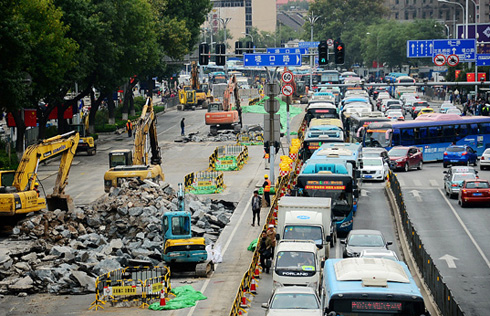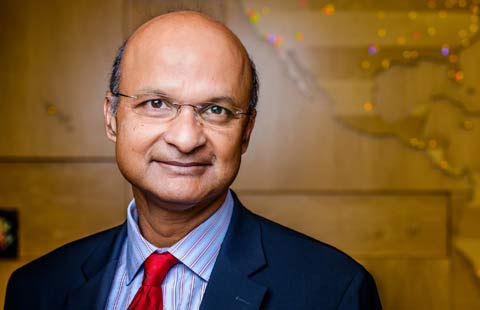When AI meets the Silk Road
BEIJING/DUNHUANG - "Hello, this is XiaoIce in Dunhuang, your cutie AI (artificial intelligence) chatbot. You are free to discuss anything with me and I'll help you explore the world's cultural heritage as best I can."
On an apricot blossom April day at the 1,600-year-old Mogao Caves in Dunhuang, China's northwestern province of Gansu, a major ancient Silk Road hub, Lu Xiaoqiang was joyfully talking with the 24-hour online Chinese chatbot on his cellphone.
"How many caves are (there) in Mogao?" asked Lu, who was traveling from China's southeast province of Fujian.
Within a second, XiaoIce replied, "Of the 735 caves, 492 remain intact more or less."
Dunhuang XiaoIce, jointly developed by Microsoft and the Dunhuang Academy, made her debut in October last year, when AI saw drastic development in China. Within months, XiaoIce quickly became an online celebrity.
"Interesting! It's just like chatting with your close friends," Lu said. "I was able to learn from her all sorts of things including the history and culture of the Mogao Caves and Dunhuang, and most importantly, in an easy and relaxing way."
Dunhuang XiaoIce knows the entire thousand-page "Dunhuang Dictionary." In addition, she's able to absorb far more information through thousands of online conversations every day. The latest statistics show that the AI chatbot can reach around 2 million people every year, helping them better understand the mysterious Mogao Caves.
Dating back to 366AD, a Buddhist monk named Le Zun had a vision of a thousand Buddhas bathed in golden light at the Mount Mogao, which inspired him to build a cave there. That was when the Mogao Caves started and later gradually grew. Situated at a strategic point along the Silk Road, at the crossroads of trade as well as religious, cultural and intellectual influences, the 492 cells and cave sanctuaries in Mogao are famous for their statues and wall paintings, spanning 1,000 years of Buddhist art.
At that time, the monk Le must have never expected that his story and the essence of the ancient cave would be told by an artificial intelligence chatbot someday in the future.
The field of artificial intelligence research, born some 60 years ago, has experienced explosive growth in recent years thanks to the fast development of big data analytics and cloud computing and is highly expected to shape the world's Tomorrowland.
Today, when AI meets ancient Dunhuang, it is expected to revolutionize communication, bringing new opportunities for the Belt and Road Initiative, unveiled three years ago.
"XiaoIce has offered a different way for people, to get information and learn about the Dunhuang culture. It was especially beloved by the younger generation," Wang Xudong, dean of the Dunhuang Academy, told Xinhua in an interview.
Wang said that the integration of AI technology and cultural studies also changed the way of preserving cultural relics and spreading Chinese culture.
As a matter of fact, Microsoft Research Asia is just one of the thousand high-tech companies, located at Zhongguancun, China's National Innovation Model Park, to participate into the Belt and Road Initiative.
Dr Hsiao-Wuen Hon, corporate vice president of Microsoft, chairman of Microsoft's Asia-Pacific R&D Group, and managing director of Microsoft Research Asia, told Xinhua that in the age of mobile Internet, AI can help people gain easy access to different cultures along the Belt and Road route in a fastest and most effective way, breaking down space and time barriers.
In addition to chatbots, digital technology, virtual reality (VR), augmented reality (AR), mixed reality (MR), cloud-based instant translation and other frontier technologies are being closely combined with AI technology.
Another example is Microsoft Research Asia's work with the Dunhuang Academy to develop a Gigapixel Camera system that digitally captures high-resolution, large-format images of the Mogao Caves and resolves details not visible to the naked eye. The highly-detailed images captured by the Gigapixel Camera enables the Dunhuang scholars to preserve those valuable cultural artifacts for future generations.
"Digital technology gives life to cultural heritage, enabling an ancient culture to reach millions of households via the Internet," Wang said.
Also in April, a digital exhibition called "Dunhuang on the Silk Road" was held in Beijing, some 2,400 km away from Dunhuang. With the combination of VR, AR and other high-technology, visitors were able to receive an audio-visual feast of the Silk Road treasure.
"Culture and technology complement each other," Hon said. "This allows them to stimulate more innovation.






















